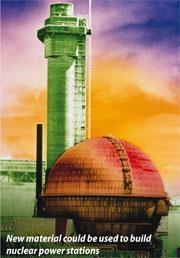Scientists have discovered new materials that can undo the damage caused by radiation and so might be useful as construction components for nuclear power stations that would be able to withstand many years of exposure to radioactive substances.

Xian-Ming Bai and colleagues at the Los Alamos National Laboratory (LANL), US, showed, using computer simulations on nano-crystalline copper materials, that when these materials are exposed to radiation and damage occurs they can 'heal' themselves by reversing the migration of atoms within the material's structure when it is further bombarded with radiation.
Radiation causes defects within a crystal structure, ie the formation of interstitial atoms/vacancies that weaken the structure on the microscopic scale. These tiny faults accumulate, leading to swelling and hardening of the substance, which in turns causes brittleness and the potential for cracks to form and the materials to fail.
In the new materials, there are many more boundaries between the crystalline grains than in a conventional construction material. Bai and colleagues, using atomistic computer simulation methods, investigated defect-grain boundary interactions in copper on the picosecond to microsecond timescales.
The simulations revealed that grain boundaries can load and then unload interstitial, or misplaced atoms that migrate from one part of a crystal to another because they absorb energy from the incident radiation. This process relocates the interstitial atoms and eradicates gaps, or vacancies, that would otherwise cause structural damage. The simulations concur with experimental observations made by other researchers.
The LANL team is currently trying to demonstrate the effect on test materials in the laboratory.
References
- X-M. Bai et al, Science, 2010, 327, 1631






No comments yet